Undergraduate Lab Exercise: A Rat Model of Fetal Alcohol Syndrome
VerifiedAdded on 2021/05/10
|7
|1718
|33
Report
AI Summary
This report details an undergraduate laboratory exercise designed for biopsychology courses, focusing on a rat model of Fetal Alcohol Syndrome (FAS). The research explores the effects of alcohol consumption during pregnancy on offspring, using rat pups to simulate the condition. Experiments include observing ultrasonic vocalizations, hyperactivity, balance, and spatial learning. The study involves intraperitoneal alcohol injections, blood alcohol concentration analysis, and behavioral tests such as open field tests and the Morris water maze. The report discusses the benefits of animal models in understanding FAS, ethical considerations, and the potential for clinical applications. The findings highlight the severe impact of alcohol exposure on the developing nervous system and the flexibility of the experimental procedures. The report also discusses the cost-effectiveness of these experiments and the importance of connecting theoretical concepts with experimental results. The author suggests improvements for future research, including a stronger emphasis on connecting results with human behavior and more detailed experimental descriptions.

A Rat Model of Fetal Alcohol Syndrome: A series of undergraduate laboratory exercise for biopsychology
courses.
courses.
Paraphrase This Document
Need a fresh take? Get an instant paraphrase of this document with our AI Paraphraser
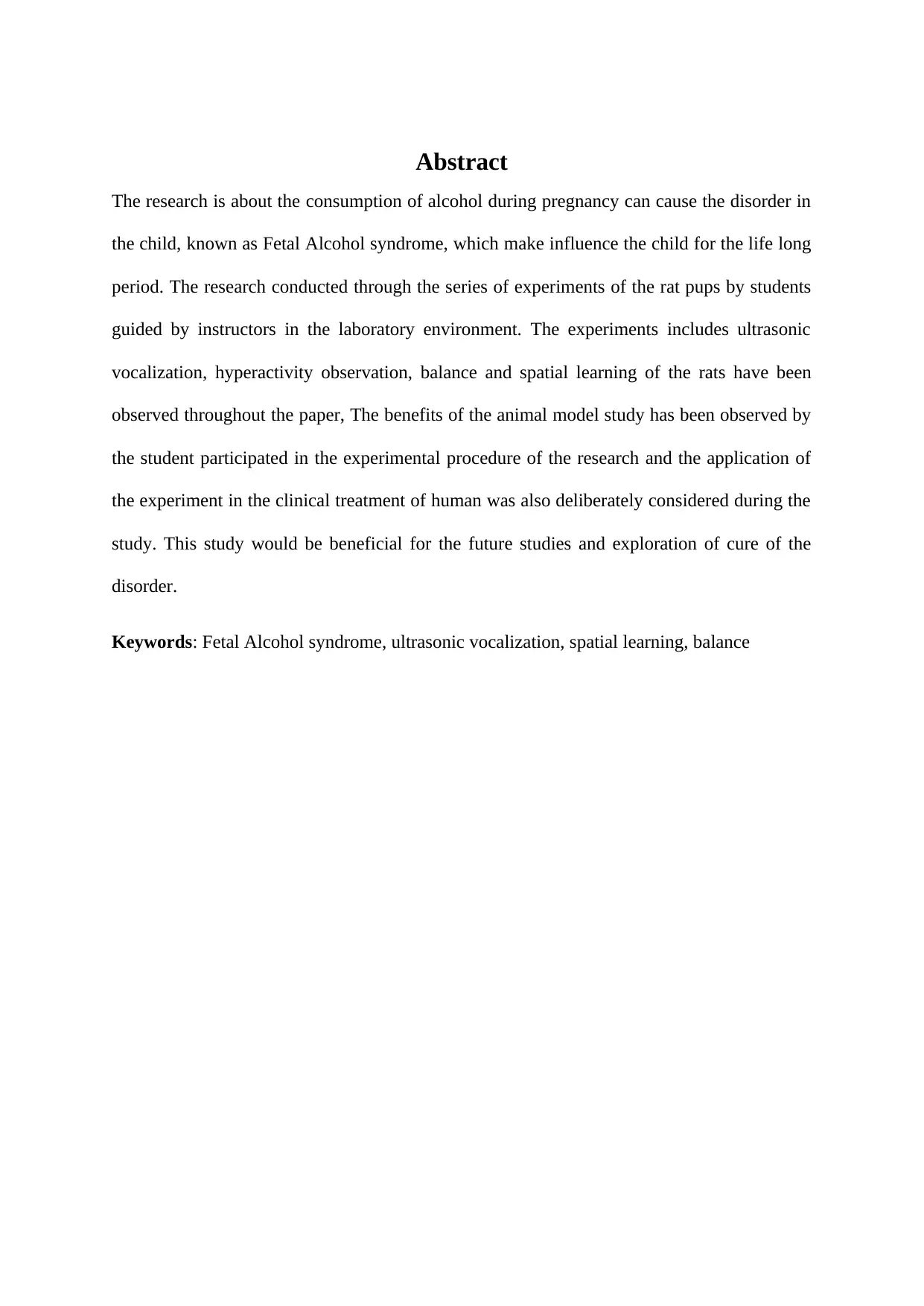
Abstract
The research is about the consumption of alcohol during pregnancy can cause the disorder in
the child, known as Fetal Alcohol syndrome, which make influence the child for the life long
period. The research conducted through the series of experiments of the rat pups by students
guided by instructors in the laboratory environment. The experiments includes ultrasonic
vocalization, hyperactivity observation, balance and spatial learning of the rats have been
observed throughout the paper, The benefits of the animal model study has been observed by
the student participated in the experimental procedure of the research and the application of
the experiment in the clinical treatment of human was also deliberately considered during the
study. This study would be beneficial for the future studies and exploration of cure of the
disorder.
Keywords: Fetal Alcohol syndrome, ultrasonic vocalization, spatial learning, balance
The research is about the consumption of alcohol during pregnancy can cause the disorder in
the child, known as Fetal Alcohol syndrome, which make influence the child for the life long
period. The research conducted through the series of experiments of the rat pups by students
guided by instructors in the laboratory environment. The experiments includes ultrasonic
vocalization, hyperactivity observation, balance and spatial learning of the rats have been
observed throughout the paper, The benefits of the animal model study has been observed by
the student participated in the experimental procedure of the research and the application of
the experiment in the clinical treatment of human was also deliberately considered during the
study. This study would be beneficial for the future studies and exploration of cure of the
disorder.
Keywords: Fetal Alcohol syndrome, ultrasonic vocalization, spatial learning, balance
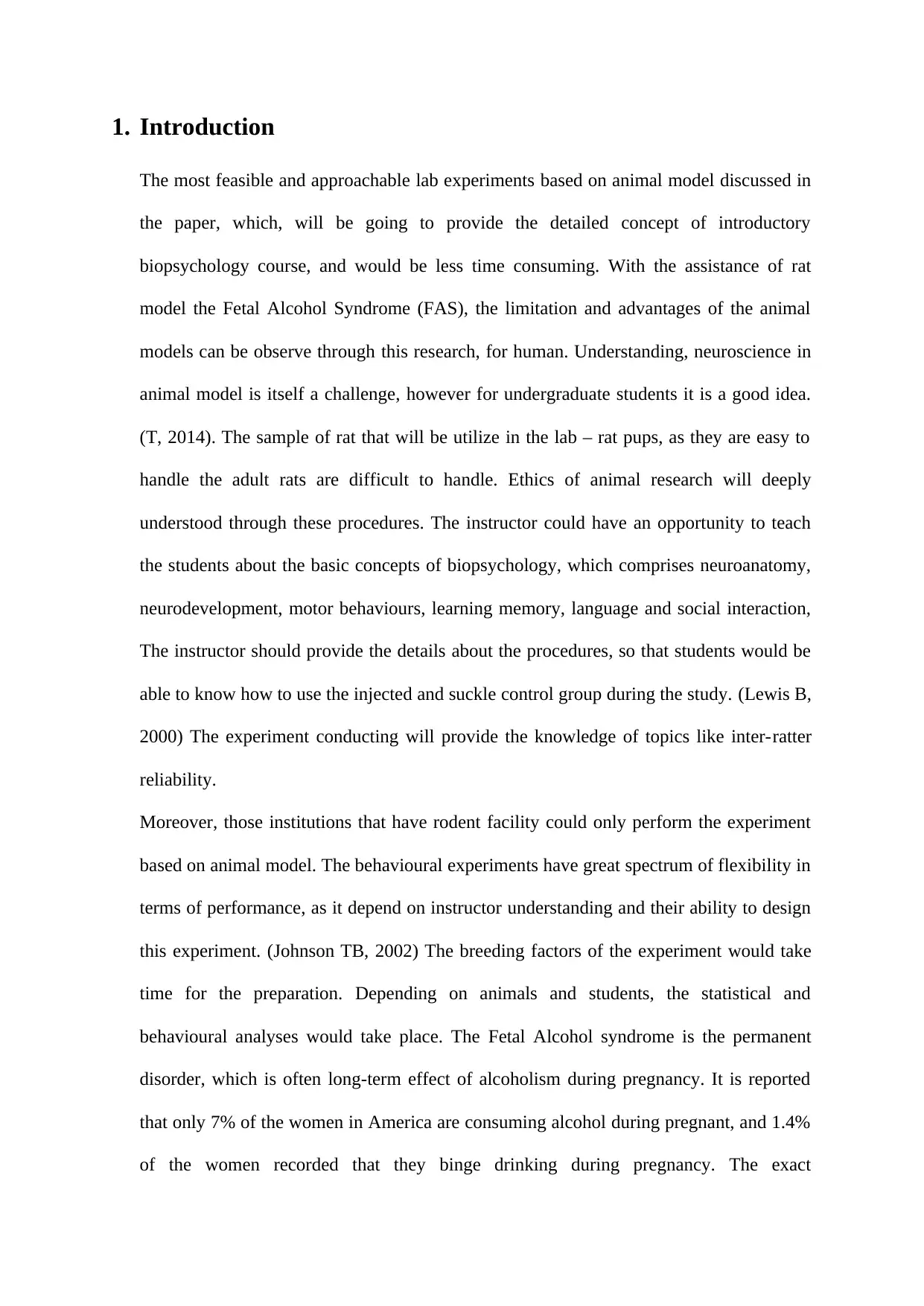
1. Introduction
The most feasible and approachable lab experiments based on animal model discussed in
the paper, which, will be going to provide the detailed concept of introductory
biopsychology course, and would be less time consuming. With the assistance of rat
model the Fetal Alcohol Syndrome (FAS), the limitation and advantages of the animal
models can be observe through this research, for human. Understanding, neuroscience in
animal model is itself a challenge, however for undergraduate students it is a good idea.
(T, 2014). The sample of rat that will be utilize in the lab – rat pups, as they are easy to
handle the adult rats are difficult to handle. Ethics of animal research will deeply
understood through these procedures. The instructor could have an opportunity to teach
the students about the basic concepts of biopsychology, which comprises neuroanatomy,
neurodevelopment, motor behaviours, learning memory, language and social interaction,
The instructor should provide the details about the procedures, so that students would be
able to know how to use the injected and suckle control group during the study. (Lewis B,
2000) The experiment conducting will provide the knowledge of topics like inter-ratter
reliability.
Moreover, those institutions that have rodent facility could only perform the experiment
based on animal model. The behavioural experiments have great spectrum of flexibility in
terms of performance, as it depend on instructor understanding and their ability to design
this experiment. (Johnson TB, 2002) The breeding factors of the experiment would take
time for the preparation. Depending on animals and students, the statistical and
behavioural analyses would take place. The Fetal Alcohol syndrome is the permanent
disorder, which is often long-term effect of alcoholism during pregnancy. It is reported
that only 7% of the women in America are consuming alcohol during pregnant, and 1.4%
of the women recorded that they binge drinking during pregnancy. The exact
The most feasible and approachable lab experiments based on animal model discussed in
the paper, which, will be going to provide the detailed concept of introductory
biopsychology course, and would be less time consuming. With the assistance of rat
model the Fetal Alcohol Syndrome (FAS), the limitation and advantages of the animal
models can be observe through this research, for human. Understanding, neuroscience in
animal model is itself a challenge, however for undergraduate students it is a good idea.
(T, 2014). The sample of rat that will be utilize in the lab – rat pups, as they are easy to
handle the adult rats are difficult to handle. Ethics of animal research will deeply
understood through these procedures. The instructor could have an opportunity to teach
the students about the basic concepts of biopsychology, which comprises neuroanatomy,
neurodevelopment, motor behaviours, learning memory, language and social interaction,
The instructor should provide the details about the procedures, so that students would be
able to know how to use the injected and suckle control group during the study. (Lewis B,
2000) The experiment conducting will provide the knowledge of topics like inter-ratter
reliability.
Moreover, those institutions that have rodent facility could only perform the experiment
based on animal model. The behavioural experiments have great spectrum of flexibility in
terms of performance, as it depend on instructor understanding and their ability to design
this experiment. (Johnson TB, 2002) The breeding factors of the experiment would take
time for the preparation. Depending on animals and students, the statistical and
behavioural analyses would take place. The Fetal Alcohol syndrome is the permanent
disorder, which is often long-term effect of alcoholism during pregnancy. It is reported
that only 7% of the women in America are consuming alcohol during pregnant, and 1.4%
of the women recorded that they binge drinking during pregnancy. The exact
⊘ This is a preview!⊘
Do you want full access?
Subscribe today to unlock all pages.

Trusted by 1+ million students worldwide
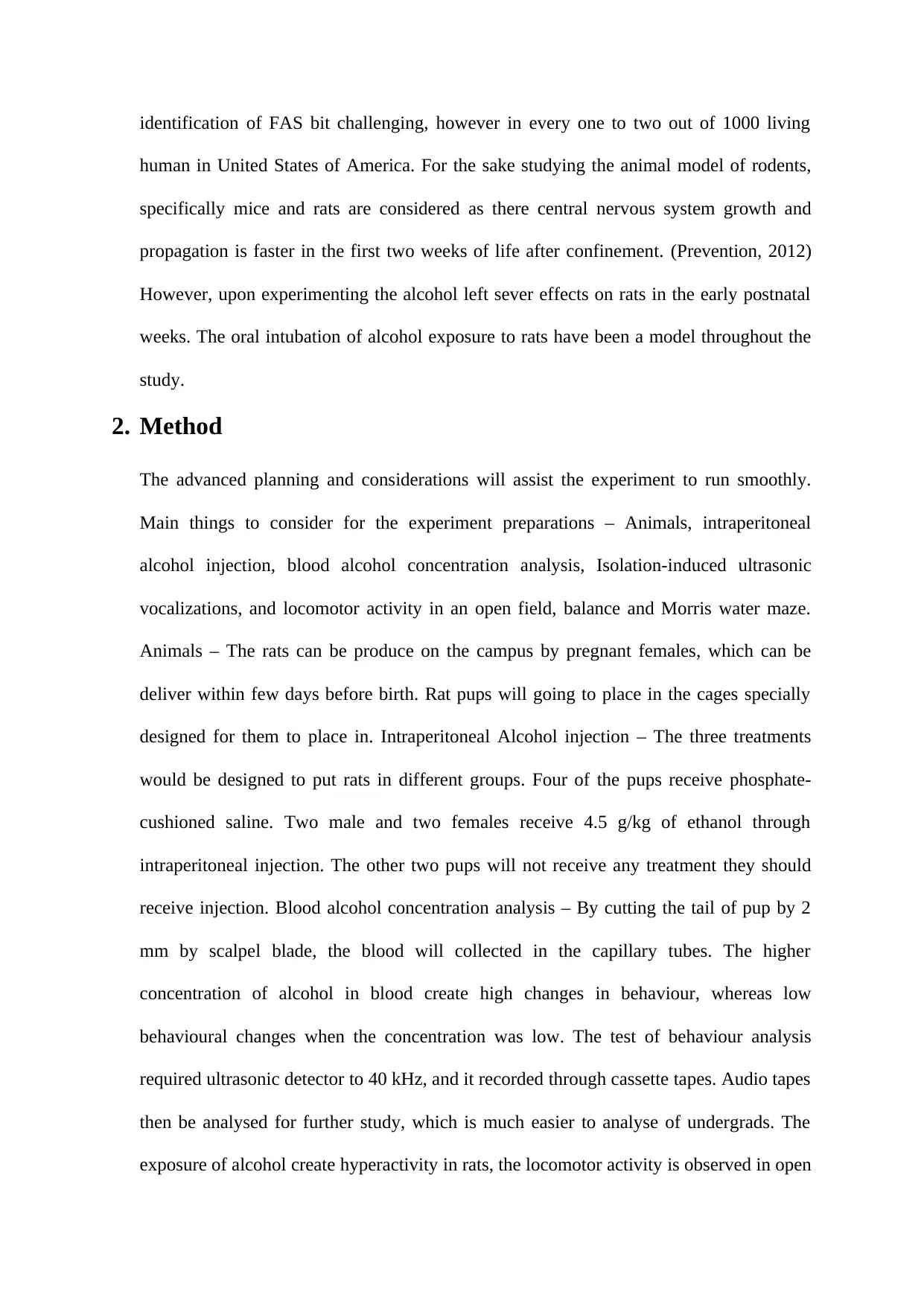
identification of FAS bit challenging, however in every one to two out of 1000 living
human in United States of America. For the sake studying the animal model of rodents,
specifically mice and rats are considered as there central nervous system growth and
propagation is faster in the first two weeks of life after confinement. (Prevention, 2012)
However, upon experimenting the alcohol left sever effects on rats in the early postnatal
weeks. The oral intubation of alcohol exposure to rats have been a model throughout the
study.
2. Method
The advanced planning and considerations will assist the experiment to run smoothly.
Main things to consider for the experiment preparations – Animals, intraperitoneal
alcohol injection, blood alcohol concentration analysis, Isolation-induced ultrasonic
vocalizations, and locomotor activity in an open field, balance and Morris water maze.
Animals – The rats can be produce on the campus by pregnant females, which can be
deliver within few days before birth. Rat pups will going to place in the cages specially
designed for them to place in. Intraperitoneal Alcohol injection – The three treatments
would be designed to put rats in different groups. Four of the pups receive phosphate-
cushioned saline. Two male and two females receive 4.5 g/kg of ethanol through
intraperitoneal injection. The other two pups will not receive any treatment they should
receive injection. Blood alcohol concentration analysis – By cutting the tail of pup by 2
mm by scalpel blade, the blood will collected in the capillary tubes. The higher
concentration of alcohol in blood create high changes in behaviour, whereas low
behavioural changes when the concentration was low. The test of behaviour analysis
required ultrasonic detector to 40 kHz, and it recorded through cassette tapes. Audio tapes
then be analysed for further study, which is much easier to analyse of undergrads. The
exposure of alcohol create hyperactivity in rats, the locomotor activity is observed in open
human in United States of America. For the sake studying the animal model of rodents,
specifically mice and rats are considered as there central nervous system growth and
propagation is faster in the first two weeks of life after confinement. (Prevention, 2012)
However, upon experimenting the alcohol left sever effects on rats in the early postnatal
weeks. The oral intubation of alcohol exposure to rats have been a model throughout the
study.
2. Method
The advanced planning and considerations will assist the experiment to run smoothly.
Main things to consider for the experiment preparations – Animals, intraperitoneal
alcohol injection, blood alcohol concentration analysis, Isolation-induced ultrasonic
vocalizations, and locomotor activity in an open field, balance and Morris water maze.
Animals – The rats can be produce on the campus by pregnant females, which can be
deliver within few days before birth. Rat pups will going to place in the cages specially
designed for them to place in. Intraperitoneal Alcohol injection – The three treatments
would be designed to put rats in different groups. Four of the pups receive phosphate-
cushioned saline. Two male and two females receive 4.5 g/kg of ethanol through
intraperitoneal injection. The other two pups will not receive any treatment they should
receive injection. Blood alcohol concentration analysis – By cutting the tail of pup by 2
mm by scalpel blade, the blood will collected in the capillary tubes. The higher
concentration of alcohol in blood create high changes in behaviour, whereas low
behavioural changes when the concentration was low. The test of behaviour analysis
required ultrasonic detector to 40 kHz, and it recorded through cassette tapes. Audio tapes
then be analysed for further study, which is much easier to analyse of undergrads. The
exposure of alcohol create hyperactivity in rats, the locomotor activity is observed in open
Paraphrase This Document
Need a fresh take? Get an instant paraphrase of this document with our AI Paraphraser
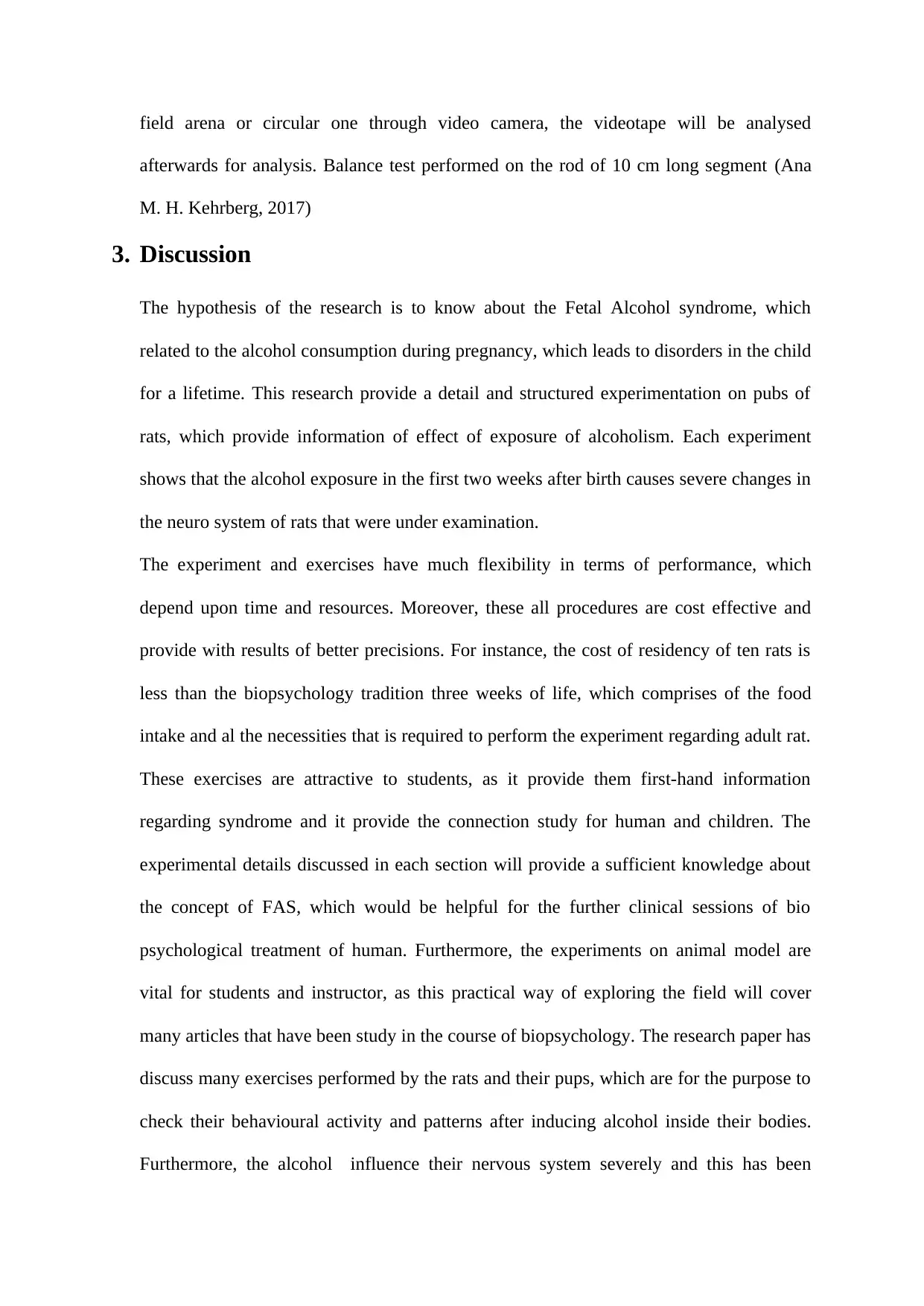
field arena or circular one through video camera, the videotape will be analysed
afterwards for analysis. Balance test performed on the rod of 10 cm long segment (Ana
M. H. Kehrberg, 2017)
3. Discussion
The hypothesis of the research is to know about the Fetal Alcohol syndrome, which
related to the alcohol consumption during pregnancy, which leads to disorders in the child
for a lifetime. This research provide a detail and structured experimentation on pubs of
rats, which provide information of effect of exposure of alcoholism. Each experiment
shows that the alcohol exposure in the first two weeks after birth causes severe changes in
the neuro system of rats that were under examination.
The experiment and exercises have much flexibility in terms of performance, which
depend upon time and resources. Moreover, these all procedures are cost effective and
provide with results of better precisions. For instance, the cost of residency of ten rats is
less than the biopsychology tradition three weeks of life, which comprises of the food
intake and al the necessities that is required to perform the experiment regarding adult rat.
These exercises are attractive to students, as it provide them first-hand information
regarding syndrome and it provide the connection study for human and children. The
experimental details discussed in each section will provide a sufficient knowledge about
the concept of FAS, which would be helpful for the further clinical sessions of bio
psychological treatment of human. Furthermore, the experiments on animal model are
vital for students and instructor, as this practical way of exploring the field will cover
many articles that have been study in the course of biopsychology. The research paper has
discuss many exercises performed by the rats and their pups, which are for the purpose to
check their behavioural activity and patterns after inducing alcohol inside their bodies.
Furthermore, the alcohol influence their nervous system severely and this has been
afterwards for analysis. Balance test performed on the rod of 10 cm long segment (Ana
M. H. Kehrberg, 2017)
3. Discussion
The hypothesis of the research is to know about the Fetal Alcohol syndrome, which
related to the alcohol consumption during pregnancy, which leads to disorders in the child
for a lifetime. This research provide a detail and structured experimentation on pubs of
rats, which provide information of effect of exposure of alcoholism. Each experiment
shows that the alcohol exposure in the first two weeks after birth causes severe changes in
the neuro system of rats that were under examination.
The experiment and exercises have much flexibility in terms of performance, which
depend upon time and resources. Moreover, these all procedures are cost effective and
provide with results of better precisions. For instance, the cost of residency of ten rats is
less than the biopsychology tradition three weeks of life, which comprises of the food
intake and al the necessities that is required to perform the experiment regarding adult rat.
These exercises are attractive to students, as it provide them first-hand information
regarding syndrome and it provide the connection study for human and children. The
experimental details discussed in each section will provide a sufficient knowledge about
the concept of FAS, which would be helpful for the further clinical sessions of bio
psychological treatment of human. Furthermore, the experiments on animal model are
vital for students and instructor, as this practical way of exploring the field will cover
many articles that have been study in the course of biopsychology. The research paper has
discuss many exercises performed by the rats and their pups, which are for the purpose to
check their behavioural activity and patterns after inducing alcohol inside their bodies.
Furthermore, the alcohol influence their nervous system severely and this has been
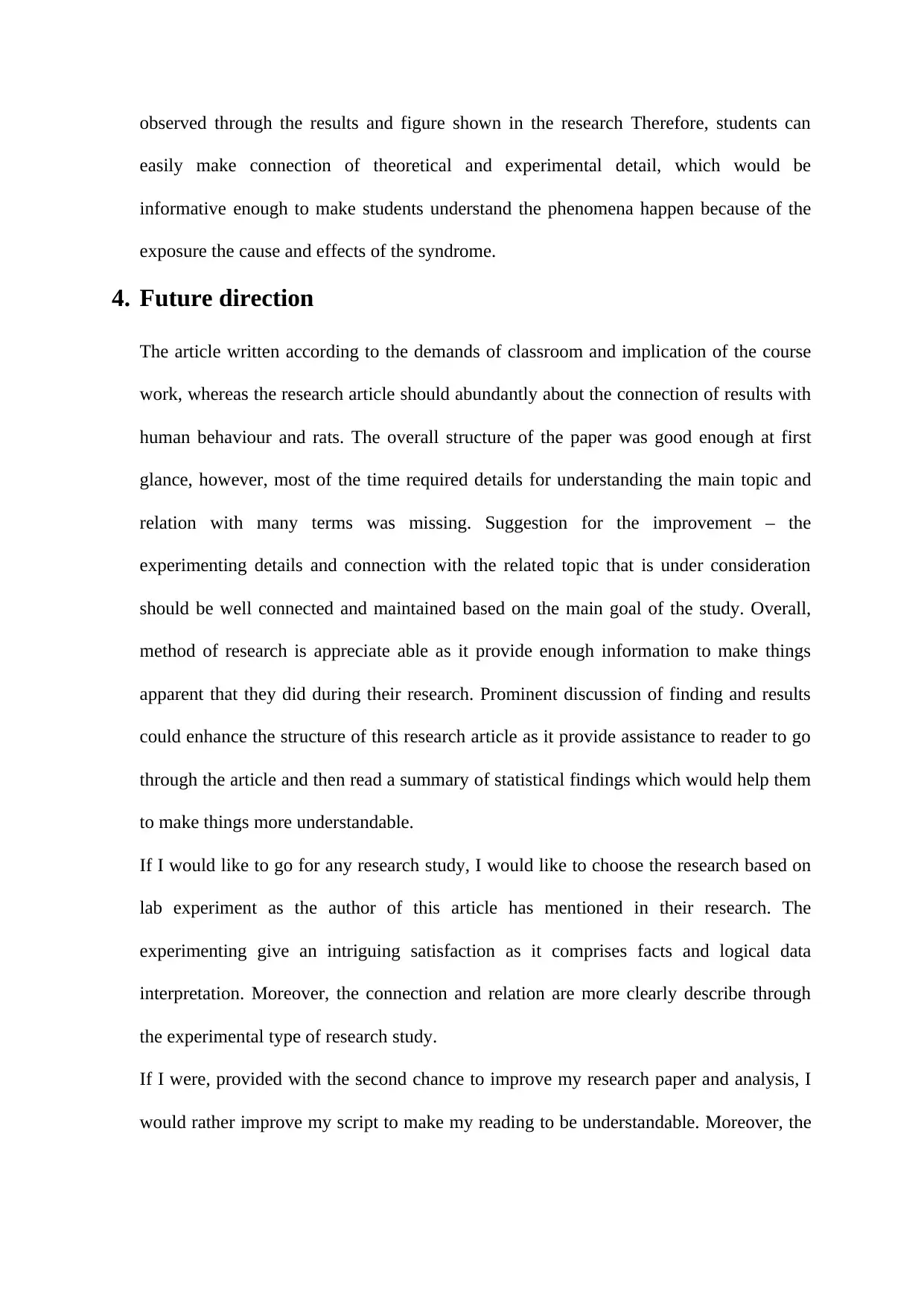
observed through the results and figure shown in the research Therefore, students can
easily make connection of theoretical and experimental detail, which would be
informative enough to make students understand the phenomena happen because of the
exposure the cause and effects of the syndrome.
4. Future direction
The article written according to the demands of classroom and implication of the course
work, whereas the research article should abundantly about the connection of results with
human behaviour and rats. The overall structure of the paper was good enough at first
glance, however, most of the time required details for understanding the main topic and
relation with many terms was missing. Suggestion for the improvement – the
experimenting details and connection with the related topic that is under consideration
should be well connected and maintained based on the main goal of the study. Overall,
method of research is appreciate able as it provide enough information to make things
apparent that they did during their research. Prominent discussion of finding and results
could enhance the structure of this research article as it provide assistance to reader to go
through the article and then read a summary of statistical findings which would help them
to make things more understandable.
If I would like to go for any research study, I would like to choose the research based on
lab experiment as the author of this article has mentioned in their research. The
experimenting give an intriguing satisfaction as it comprises facts and logical data
interpretation. Moreover, the connection and relation are more clearly describe through
the experimental type of research study.
If I were, provided with the second chance to improve my research paper and analysis, I
would rather improve my script to make my reading to be understandable. Moreover, the
easily make connection of theoretical and experimental detail, which would be
informative enough to make students understand the phenomena happen because of the
exposure the cause and effects of the syndrome.
4. Future direction
The article written according to the demands of classroom and implication of the course
work, whereas the research article should abundantly about the connection of results with
human behaviour and rats. The overall structure of the paper was good enough at first
glance, however, most of the time required details for understanding the main topic and
relation with many terms was missing. Suggestion for the improvement – the
experimenting details and connection with the related topic that is under consideration
should be well connected and maintained based on the main goal of the study. Overall,
method of research is appreciate able as it provide enough information to make things
apparent that they did during their research. Prominent discussion of finding and results
could enhance the structure of this research article as it provide assistance to reader to go
through the article and then read a summary of statistical findings which would help them
to make things more understandable.
If I would like to go for any research study, I would like to choose the research based on
lab experiment as the author of this article has mentioned in their research. The
experimenting give an intriguing satisfaction as it comprises facts and logical data
interpretation. Moreover, the connection and relation are more clearly describe through
the experimental type of research study.
If I were, provided with the second chance to improve my research paper and analysis, I
would rather improve my script to make my reading to be understandable. Moreover, the
⊘ This is a preview!⊘
Do you want full access?
Subscribe today to unlock all pages.

Trusted by 1+ million students worldwide
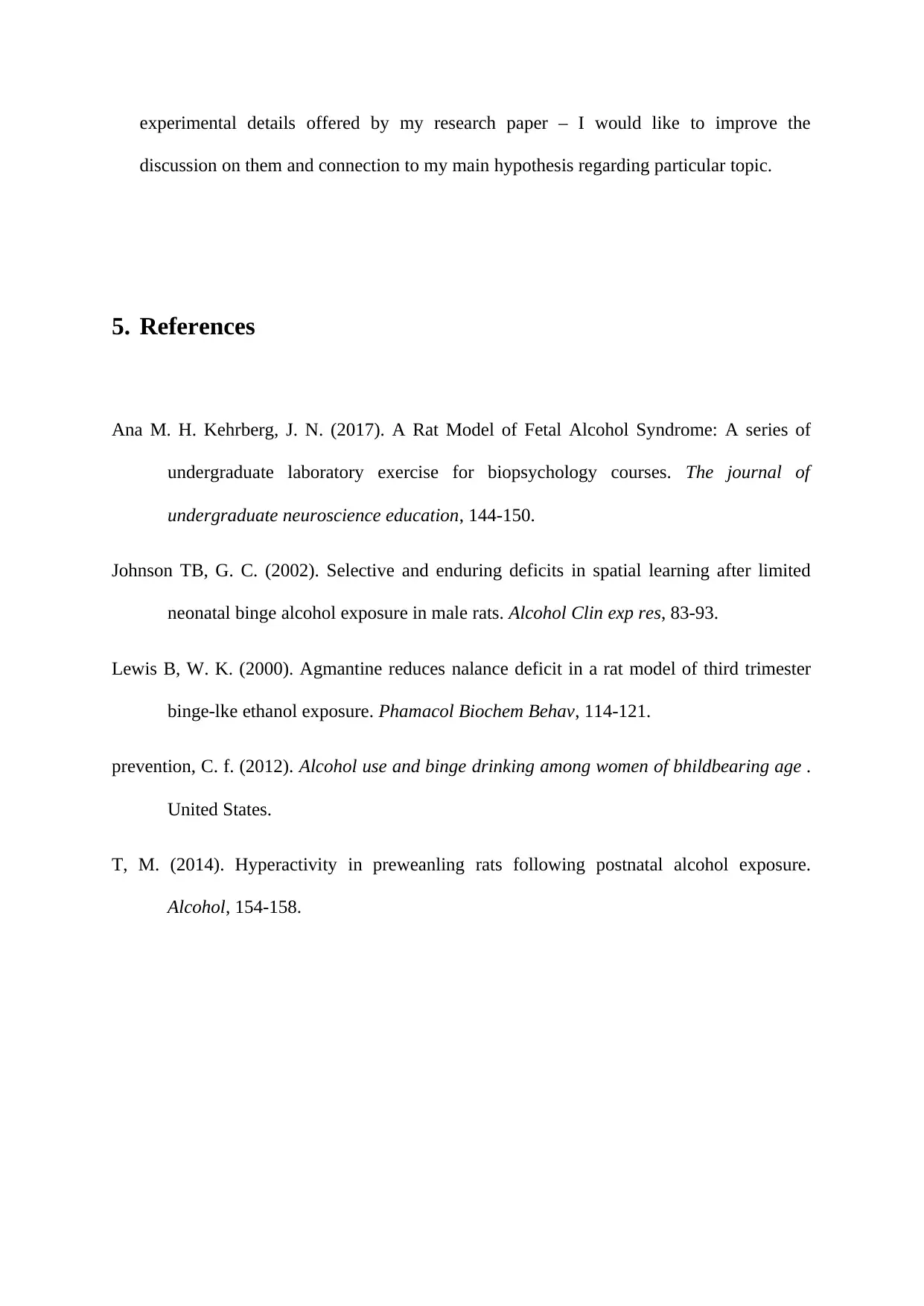
experimental details offered by my research paper – I would like to improve the
discussion on them and connection to my main hypothesis regarding particular topic.
5. References
Ana M. H. Kehrberg, J. N. (2017). A Rat Model of Fetal Alcohol Syndrome: A series of
undergraduate laboratory exercise for biopsychology courses. The journal of
undergraduate neuroscience education, 144-150.
Johnson TB, G. C. (2002). Selective and enduring deficits in spatial learning after limited
neonatal binge alcohol exposure in male rats. Alcohol Clin exp res, 83-93.
Lewis B, W. K. (2000). Agmantine reduces nalance deficit in a rat model of third trimester
binge-lke ethanol exposure. Phamacol Biochem Behav, 114-121.
prevention, C. f. (2012). Alcohol use and binge drinking among women of bhildbearing age .
United States.
T, M. (2014). Hyperactivity in preweanling rats following postnatal alcohol exposure.
Alcohol, 154-158.
discussion on them and connection to my main hypothesis regarding particular topic.
5. References
Ana M. H. Kehrberg, J. N. (2017). A Rat Model of Fetal Alcohol Syndrome: A series of
undergraduate laboratory exercise for biopsychology courses. The journal of
undergraduate neuroscience education, 144-150.
Johnson TB, G. C. (2002). Selective and enduring deficits in spatial learning after limited
neonatal binge alcohol exposure in male rats. Alcohol Clin exp res, 83-93.
Lewis B, W. K. (2000). Agmantine reduces nalance deficit in a rat model of third trimester
binge-lke ethanol exposure. Phamacol Biochem Behav, 114-121.
prevention, C. f. (2012). Alcohol use and binge drinking among women of bhildbearing age .
United States.
T, M. (2014). Hyperactivity in preweanling rats following postnatal alcohol exposure.
Alcohol, 154-158.
1 out of 7
Your All-in-One AI-Powered Toolkit for Academic Success.
+13062052269
info@desklib.com
Available 24*7 on WhatsApp / Email
![[object Object]](/_next/static/media/star-bottom.7253800d.svg)
Unlock your academic potential
Copyright © 2020–2025 A2Z Services. All Rights Reserved. Developed and managed by ZUCOL.